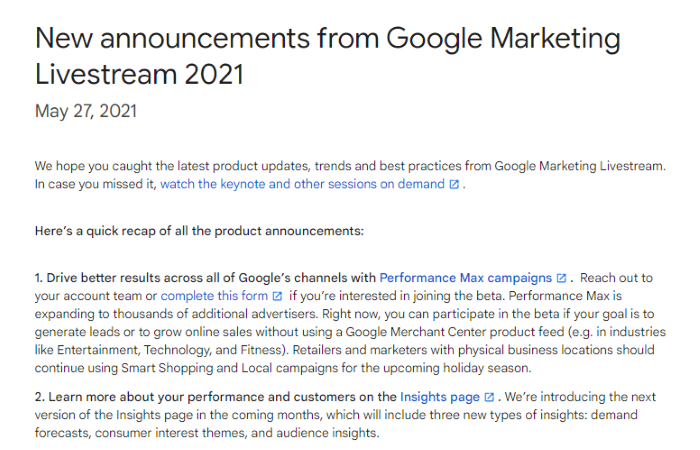
Do you wish you could spend less time managing your paid ads campaign while driving the same, if not more, conversions? Then you’re in luck. Your Google Fairy Godmother is here to make that dream come true.
Enter Performance Max campaigns, which use AI and machine learning to improve your advertising strategy and offer a hands-off approach to winning with PPC.
Excited? Well, here’s everything you need to know about Performance Max campaigns, when to use them, and how to create your own.
Performance Max Campaigns: What Are They?
Google first introduced Performance Max campaigns at its Google Marketing Livestream event in May 2021.

Performance Max campaigns are the first fully automated ad campaign of their kind. Unlike traditional Google Ad campaigns, Google automates the targeting and delivery of Performance Max campaigns based on the information you provide. All advertisers need to do is provide a series of ad creatives (a call to action, additional ad copy, and relevant images or videos), and Google takes care of the rest.
It also stands apart from anything else currently on offer by allowing you to access all of Google’s ad inventory from one lone campaign. YouTube, Search, Display, Gmail, Google will run and test creatives on every channel to meet your goals.
In short, you get access to Google’s entire inventory of ad space and a fully automated ad campaign with as little effort as possible.
Who and When Should You Use Performance Max Campaigns?
The great thing about Performance Max campaigns is because they use all of Google’s ad inventory, you can use them for pretty much any kind of campaign.
That doesn’t mean Performance Max campaigns will be everyone’s cup of tea, however. PPC experts who can eke out a lot more revenue by optimizing every facet of a campaign probably won’t enjoy the set-and-forget nature of Performance Max campaigns.
However, it makes the campaigns perfect for small and medium-sized business owners who don’t have much time or a dedicated team to run campaigns.
Performance Max campaigns are also perfect if you:
- don’t have the time or knowledge to optimize your own campaigns
- want good ad performance but don’t want to pay for a PPC agency
- don’t have the necessary budget to target all of Google’s ad inventory individually
- have a large budget and want to discover new angles that result from these campaigns
- want to optimize the performance of your campaigns but don’t care which channels your ads appear on
- want to simplify your PPC advertising with a single campaign
As for which industries are best served by these ads, it’s a little difficult to tell given how new they are. Whether you’re an e-commerce store, a physical retailer, a SaaS brand, or a B2B company, I’d recommend trying them out.
Pretty much any industry can have success with Performance Max campaigns. Just make sure to set specific goals when launching your campaign.
By that, I mean focus ads on a specific product or offer, rather than your brand as a whole. Awareness campaigns aren’t as likely to see results with Performance Max advertising.
What Are the Main Advantages of a Performance Max Campaign?
Not sure if these new ads are the right choice for your brand? Let’s take a look at the advantages.
Focus on Goals
The major benefit of Performance Max is the goal-focused nature of campaigns. The primary target for Google’s campaign optimizations is to meet the goal you set at the start of the campaign. If you have a very specific goal, like acquiring trial customers for your new product, Performance Max campaigns are a great way to drive conversion.
Hands-Off Ad Optimization and Creation
Another of the biggest advantages of Performance Max campaigns is the hands-off approach that advertisers can take with their PPC campaigns. Once you’ve set the campaign up (which is incredibly quick and easy, as you’ll see below), there’s not a lot more to do.
Setting up and managing the campaign is much faster, too. There’s no need to design your creatives with Performance Max campaigns, just provide Google with all of the individual assets, and it creates ads on your behalf. You don’t need to spend time selecting which networks to run, and there’s no need to tweak the campaign while it’s live, either. Google does it all for you.
How you spend the time you save is up to you. Some business owners will focus on optimizing their business as a whole, but you could also choose to spend time optimizing your ad creatives (the one element of Performance Max campaigns you do control) to boost the campaign performance even more.
Access to More Ad Inventory
Getting access to all of Google’s inventory in one campaign is another major benefit. Before Performance Max campaigns, the barrier to entry for creating a campaign that leverages all of Google’s ad inventory would have been incredibly high. Only the biggest spending marketers would have been able to do it.
Performance Max campaigns democratize access to Google’s ad inventory in a way that we’ve never seen before and give everyone the chance to advertise across Google’s entire ad ecosystem.
Not only is this a great way to quickly reach new customer segments, but it’s also a great way to generate more PPC data you can use to inform new campaigns in the future. Who knows, you may discover an audience segment and ad inventory combination that converts like a dream.
Save Money On Marketing Costs
You don’t need to be a PPC expert to run these campaigns, either. There’s no need to guess manual testing, bidding strategies, or which ad inventory will deliver the best results. Of course, some business owners who have experience with PPC advertising may not relish relinquishing control in this manner, but it may still be profitable to experiment with Max Performance campaigns to see the kind of results it can deliver.
If it does work, you won’t need to worry about spending time managing their own campaigns, no matter how experienced they are with PPC campaigns.
Drawbacks of Performance Max Campaigns
If there’s one drawback of using Performance Max campaigns it’s reporting—an issue raised during the Google Marketing Livestream conference.
Google announced advertisers had raised issues with reporting transparency, but the search giant is taking steps to improve this feature. Reports are still limited as of writing, but this may improve in the future.
A Google Performance Max Campaign Case Study
Naturally, Google has been quick to share the positive results companies have seen from its new campaign format. This has primarily been through a case study it published with consumer loan provider MoneyMe.
The company, which was looking to rapidly increase its customer base, worked with Australian agency Sparro to launch Performance Max campaigns. The goal of the campaign was to drive new funded loans for the company’s feature product, personal loans. They started by maximizing conversions to find a baseline CPA target before switching to a target CPA strategy to boost the profitability of campaigns.
The results are impressive. Performance Max campaigns helped MoneyMe increase conversions by 22 percent and drive more than $800,000 in revenue from new loans. They also managed to reduce their CPA by 20 percent, too.

How to Create a Performance Max Campaign
Google is currently beta testing Performance Max Campaigns. You’ll need to enquire using this form to launch a campaign as soon as possible. You’ll also need to have Google Ads Conversion Tracking implemented on your site.
Once you’ve done both, follow the instructions below.
Step 1: Set a Goal
The first step in creating a Performance Max campaign is to set a goal. This could be online sales, lead generation, or offline sales.
Step 2: Set a Budget and Bidding Strategy
Next, set a budget and a bidding strategy. You can choose to maximize conversion or spend, set a maximum CPA, or set a target cost or conversion.
Step 3: Create an Asset Group
As we have discussed above, this is not an ad. It’s a collection of assets Google will use to create static and dynamic ads depending on the ad placement.
In total, you’ll need to provide Google:
- 3 headline versions
- 2 ad descriptions
- one longer headline
- a 600×316 landscape image
- a 300×300 square image
- a 314×314 square image
- a 128×128 logo
- a 10-second-plus video for video ads
Step 4: Select a Target Audience (Optional)
If you want to give Google a little help getting started, you can select a target audience. Google will automatically show your ads to the users who are most likely to convert, but you can provide signals to help Google quickly find your ideal customers.
Of course, by doing this, you may miss out on finding a yet undiscovered audience segment.
Step 5: Add Extensions
These can either be existing site-level extensions or you can create your own site links for your Performance Max campaign. Helpfully, Google suggests creating specific formats depending on your campaign objectives, like adding a form extension if you want to acquire leads.
Performance Max Campaigns Frequently Asked Questions
Do Performance Max campaigns work?
How much do Performance Max campaigns cost?
What do you need to know about Performance Max campaigns?
How does Google support Performance Max campaigns?
Performance Max Campaigns Conclusion
You don’t have to be a PPC expert or hire a PPC marketing agency to drive leads and sales for your business. Google’s Performance Max campaigns take all the hard work out of creating an effective PPC campaign, so you can focus on your business while your ads drive conversions and, most importantly, positive ROI.
These campaigns may not be profitable straight away—just like any other PPC campaign strategy—but they may deliver solid results over time. They’re definitely worth testing.
Have you launched a Performance Max campaign yet? What were your results?
from Blog – Neil Patel https://ift.tt/3CEKkcu

No comments:
Post a Comment